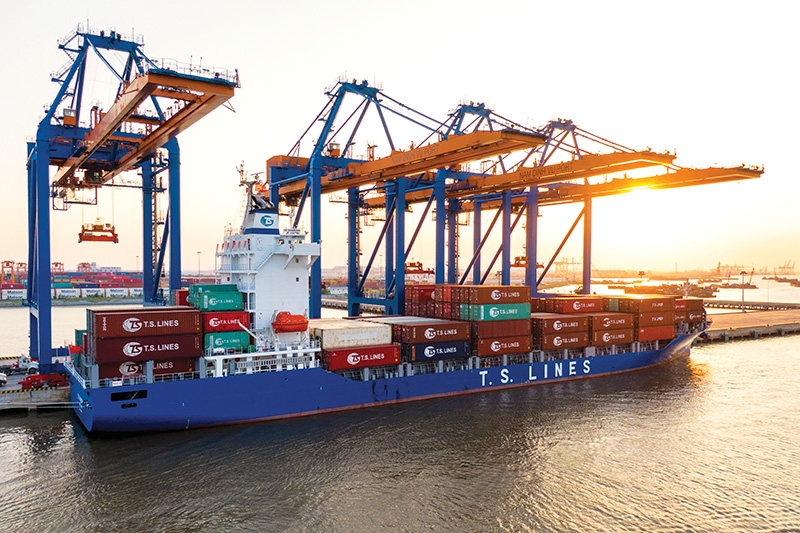Creating prosperity through strengthening of logistics
 |
| Logistics firms are concerned over seaport surcharges and other factors that increase costs, photo Dung Minh |
After the boom in e-commerce and e-logistics in 2019, Vietnam’s logistics industry has been losing momentum rapidly, with the total volume of freight in the first 10 months of 2020 standing at only 1.43 billion tonnes of cargo, down 7.5 per cent compared to the same period in 2019, according to the General Department of Vietnamese Customs.
The issue was discussed at the Vietnam Logistics Forum 2020 on November 26 in Hanoi, where participants detailed the fragmentation of Vietnam’s logistical infrastructure taking place amid a general economic slowdown, with consumers in some of Vietnam’s main export markets – especially the United States and Europe – waiting for goods.
Dao Trong Khoa, vice president of the Vietnam Logistics Business Association (VLA), forecast that the situation “will remain very difficult for the end of the year and maybe the first half of next year.”
The number of new COVID-19 infections was skyrocketing last week in the US – one of Vietnam’s most important commodity markets, putting even more pressure on its exports. Meanwhile, many localities have not yet found alternative solutions to revive the sector, with countless projects in logistics infrastructure yet to be implemented due to the impact of the pandemic.
For instance, the fact that the construction of Bac Giang’s International Logistics Centre, with a total investment of nearly VND4.2 trillion ($183 million), continues to be behind schedule due to a lack of experience in infrastructure investment and limited financial capacity, raises concerns about a possible disruption of commodity supply chains connected with economic corridors that serve international trade activities.
Vu Tien Loc, chairman of the Vietnam Chamber of Commerce and Industry, complained that the high cost of logistics services has “significantly reduced the competitiveness of Vietnamese goods and businesses” as logistics fees can sum up to 30-40 of the transported products’ costs, while this ratio is only about 15 per cent in other countries. The cost of logistical services in Vietnam, Loc said, is also equivalent to 20.9 per cent of GDP, higher than the global average of 14 per cent.
Despite about 4,000 local enterprises providing international and domestic logistics services, Khoa from the VLA acknowledged, “The country’s connectivity and infrastructure are not yet well developed.”
Developing forward
Meanwhile, factors that increase logistical costs, including seaport surcharges that foreign container ship owners are collecting from Vietnamese shippers, time for clearance of goods, and professional inspections are also prolonged. The cost of transporting goods by road is too high and the competitiveness of domestic logistics providers is lacking.
Additionally, internal factors resonating with COVID-19 have been having a clear impact on the operations of these enterprises. According to the General Statistics Office, in the first 10 months of the year, the number of newly-established transport and warehouse enterprises decreased by 5.5 per cent on-year. From the beginning of the year to the end of October, 2,366 of such companies also proceeded with their dissolution.
With one of Vietnam’s main growth drivers being exports, mainly coming from foreign-invested companies who are participating in global value chains, one of the requirements for the country is to strengthen integration and links with the domestic market to promote continuous development and prosperity.
According to the World Bank’s Vietnam Development Report 2019, transport infrastructure across the country is developing unevenly, with congestion at major border gates and serious supply-demand imbalances. Vietnam’s trade flows are concentrated at a quarter of the total number of international border gates, including two airports, five seaports, and five land crossings.
The report also stated that Vietnam’s domestic transportation system currently heavily depends on its road network, accounting for three-quarters of the total volume of goods.
However, the country has not yet taken advantage of its extensive natural network of rivers and canals as inland ports and waterways remain inadequate to accommodate larger cargo volumes. Besides this, the nation’s 2,600-km railway network is deemed out of date.
Infrastructure necessity
The recently effective new-generation free trade agreements impact domestic logistics enterprises. As such, Vietnam committed to open its markets and raised the bar for local logistics providers as the prospected volume of goods increases. Together with that, demands for increased service quality, capacity expansion, and faster deliveries also increase.
Thus, Vietnam needs a large and modern infrastructure to handle the post-pandemic exports of commodities that are expected to increase as the world’s economy gradually recovers, which is another reason for the government to further attract the attention of domestic and foreign investors.
According to Ho Chi Minh City Export Processing and Industrial Zones Management Authority (HEPZA), in the first 10 months of the year, there were 18 domestic investment projects in industrial infrastructure. During the same time, a Dutch investor also injected cash into a 20-hectare project in Tan Phu Trung Industrial Park, worth more than $81 million.
Tran Viet Ha, director of HEPZA’s investment department, said on November 5 that a major investor is currently negotiating a project in factory infrastructure for lease to attract supporting industry manufacturers and serve another project of an American corporation operating in the high-tech park of the city. HEPZA aims to complete the procedures for land lease until the end of the year.
Elsewhere, provinces like Binh Duong, Bac Ninh, and Long An are trying to establish logistic centres in their industrial zones, with most of these small in scale. However, Nguyen Thai Hoa, general director of Interserco JSC, believed that investors will pour their capital mostly into large, modern, and national logistics centres.
Even though the government has specific guidance on the development of logistics centres across the country with an orientation to 2030, Vietnam’s logistical infrastructure remains “fragmented without comprehensive planning,” commented Tran Thanh Hai, deputy director of the Ministry of Industry and Trade’s Import-Export Department. “Vietnam exports many goods, but there are no groundbreaking policies for the renovation of state management in logistics and related agencies, as well as a lack of commercial and IT infrastructure.”
Vietnam’s exports will be directly affected by the slow growth of the global economy and the ongoing US-China trade tensions. According to Hai, the participation of private investors in logistic infrastructure development is very necessary.
“In the immediate future, the government should give priority to allocating central and local funds for vital projects in regions with geo-economic advantages. To do this, it is necessary to remove infrastructure constraints and attract private investment, as well as consider solutions to deploy projects in the form of public-private partnerships,” Hai added.
| Trinh Dinh Dung - Deputy Prime Minister
The logistics sector has been booming since 1990, reaffirming its particularly important role in the Vietnamese economy. With the legal framework being increasingly completed, the logistics infrastructure in recent years has seen remarkable changes, with many large and modern projects put into operation. According to the World Bank’s Annual Report 2018, Vietnam’s logistics performance index ranked 39 out of 60 countries participating in the study – an increase of 25 places compared to 2016 – and third among ASEAN countries. Vietnam’s logistics services have a relatively high growth rate of 12-14 per cent, with about 60-70 per cent of businesses outsourcing these operations. However, besides these positive figures in recent years, the country’s industry retains shortcomings and limitations that need to be focused on effectively, including the relatively high costs of these services, which reduce our nation’s competitiveness in the global arena. |
What the stars mean:
★ Poor ★ ★ Promising ★★★ Good ★★★★ Very good ★★★★★ Exceptional
Related Contents
Latest News
More News
- Vietnam bucking trend in the global M&A landscape (December 16, 2025 | 14:20)
- Vietnam’s green transition demands collective financial action (December 15, 2025 | 12:00)
- VIR workshop highlights capital and policy for sustainable development (December 15, 2025 | 11:00)
- National Assembly approves pilot mechanisms to accelerate major projects in Hanoi (December 12, 2025 | 11:29)
- Vietnam eases policy approval requirements, simplifies foreign and outbound investments (December 11, 2025 | 17:53)
- Unpacking new momentum in Vietnam’s M&A market (December 10, 2025 | 09:59)
- Forum honours outstanding M&A deals, strategies, and advisory firms (December 09, 2025 | 18:22)
- Vietnam enters defining phase of M&A growth (December 09, 2025 | 17:00)
- Vietnam’s M&A market opens new opportunities amid strong economic momentum (December 09, 2025 | 15:00)
- Vietnam M&A Forum 2025: new position, new momentum (December 09, 2025 | 14:30)


 Tag:
Tag:





















 Mobile Version
Mobile Version